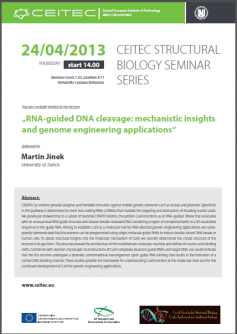Abstract:
CRISPR-Cas systems provide adaptive and heritable immunity against mobile genetic elements such as viruses and plasmids. Specificity in this pathway is determined by short non-coding RNAs (crRNAs) that mediate the targeting and destruction of invading nucleic acids. We previously showed that in a subset of bacterial CRISPR systems, the protein Cas9 functions as an RNA-guided DNase that associates with an unusual dual-RNA guide structure and cleaves double-stranded DNA containing a region of complementarity to a 20-nucleotide sequence in the guide RNA. Aiming to establish Cas9 as a molecular tool for RNA-directed genetic engineering applications, we subsequently demonstrated that the enzyme can be programmed using single-molecule guide RNAs to induce double-strand DNA breaks in human cells. To obtain structural insights into the molecular mechanism of Cas9, we recently determined the crystal structure of the enzyme in its apo form. The structure reveals the architecture of this multidomain molecular machine and defines its nucleic acid binding clefts. Combined with electron-microcopic reconstructions of Cas9 complexes bound to guide RNAs and target DNA, our results indicate that the the enzyme undergoes a dramatic conformational rearrangement upon guide RNA binding that results in the formation of a central DNA binding channel. These studies provide the framework for understanding Cas9 function at the molecular level and for the continued development of Cas9 for genetic engineering applications.
Poster to download can be found HERE.








